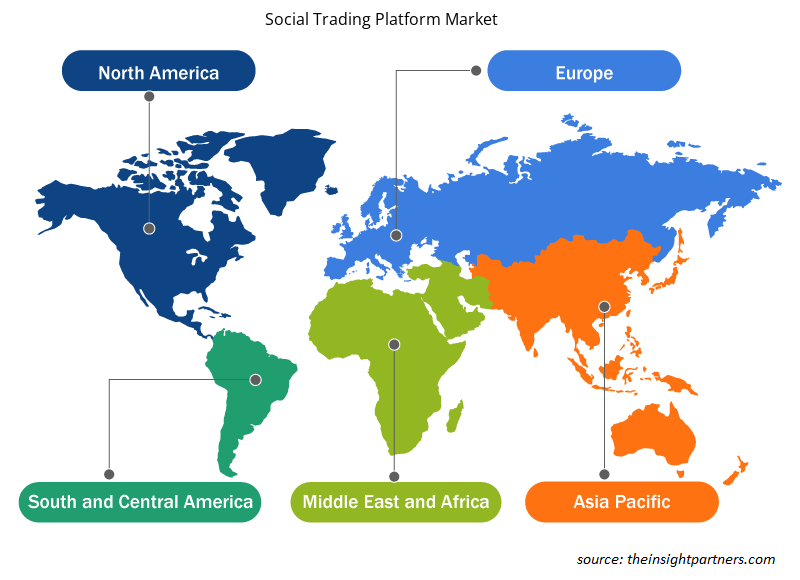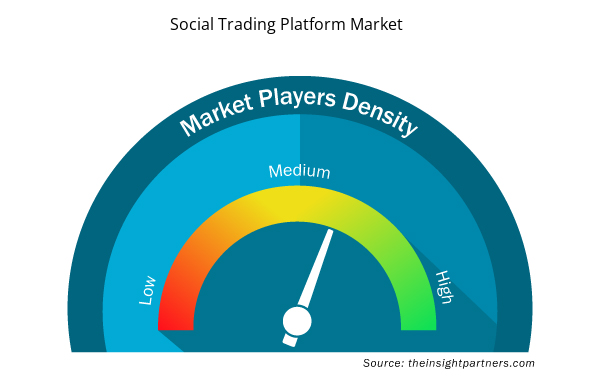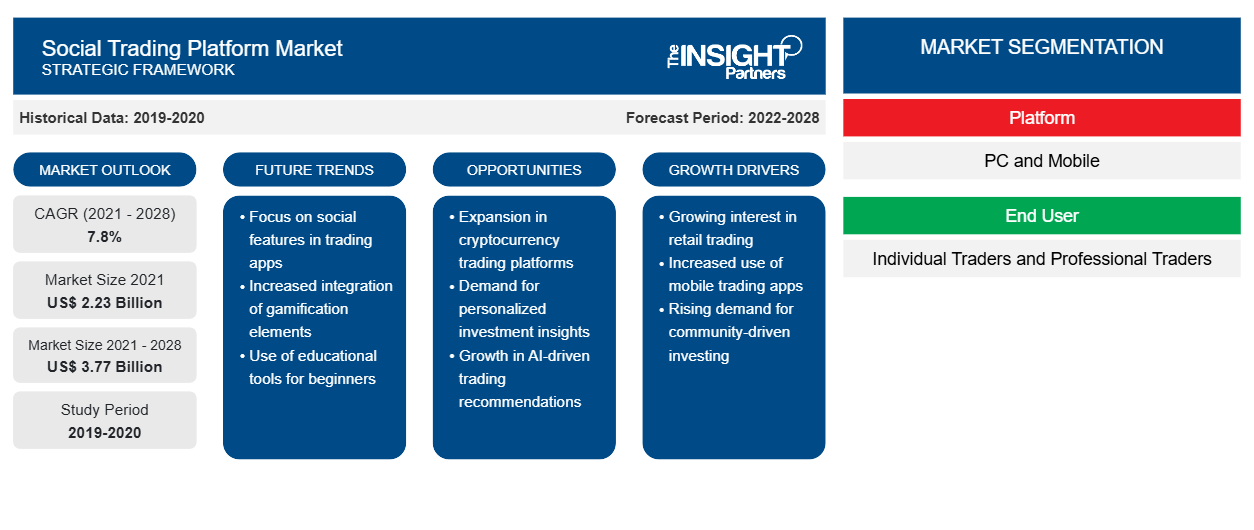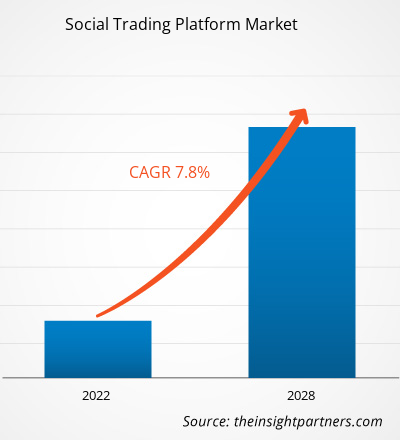Der Markt für Social-Trading-Plattformen soll von 2.229,56 Millionen US-Dollar im Jahr 2021 auf 3.774,17 Millionen US-Dollar im Jahr 2028 wachsen; zwischen 2021 und 2028 wird mit einer durchschnittlichen jährlichen Wachstumsrate von 7,8 % gerechnet.CAGR of 7.8% between 2021 and 2028.
Maßgeschneiderte Handelsplattformsoftware steigert effektiv den Umsatz der Organisationen und sorgt für eine bessere Kundenzufriedenheit. Die Händler nutzen häufig eine maßgeschneiderte Handelsplattform, da sie einfach zu verwenden ist. Die maßgeschneiderte Handelsplattform bietet den Kunden detaillierte und leicht lesbare Diagramme, Echtzeitstatistiken und maßgeschneiderte Berichtssysteme. So brachte ParagonEX (führendes Unternehmen im Bereich Finanztechnologie) im Mai 2021 eine vollständig anpassbare Handelsplattform auf den Markt, bei der seine Brokerkunden über jedes Detail des Erscheinungsbilds der Plattform entscheiden können. Die Anpassung umfasst jedes Element der Handelsplattform, was eine endlose Anpassung pro Broker oder Endbenutzer ermöglicht. Die neue Plattform ermöglicht jedem Broker ein einzigartiges Erscheinungsbild mit Elementen seiner Wahl, wodurch eine unverwechselbare Markenidentität geschaffen und das Profil und der Mix seiner Endbenutzer berücksichtigt werden.ParagonEX (financial technology leader) launched a fully customizable trading platform, allowing its broker clients to decide on every detail of the platforms' look and feel. The customization features every element of the trading platform, which allows for endless customization per broker or end-user. The new platform allows each broker to have a unique appearance, displaying elements of their choice, thus creating a distinct brand identity and catering to the profile and mix of their end-users.
Die Software bietet außerdem eine erweiterte und detaillierte Chartanalyse nach Kundenwunsch. Bei dieser Chartanalyse ist das Lesen und Verstehen bestimmter Daten in der Handelsbranche von entscheidender Bedeutung. Die erweiterte Chartanalyse bietet Benutzern einige flexible und benutzerdefinierte Funktionen, mit denen Diagramme nach den Anforderungen der Benutzer erstellt werden können. Abgesehen von den oben genannten Vorteilen bietet eine benutzerdefinierte Handelsplattform auch mehrere Optionen zum Lesen und Verstehen von Branchentrends, zum Vorhersagen von Preisschwankungen, zum Erstellen benutzerdefinierter und personalisierter Diagramme und zum Verwalten mehrerer Konten von einer einzigen Social-Trading-Plattform aus. All diese Vorteile tragen zum weltweiten Wachstum des Marktes für Social-Trading-Plattformen bei.
Passen Sie diesen Bericht Ihren Anforderungen an
Sie erhalten kostenlos individuelle Anpassungen an jedem Bericht, einschließlich Teilen dieses Berichts oder einer Analyse auf Länderebene, eines Excel-Datenpakets sowie tolle Angebote und Rabatte für Start-ups und Universitäten.
- Holen Sie sich die wichtigsten Markttrends aus diesem Bericht.Dieses KOSTENLOSE Beispiel umfasst eine Datenanalyse von Markttrends bis hin zu Schätzungen und Prognosen.
Auswirkungen der COVID-19-Pandemie auf den globalen Markt für Social-Trading-Plattformen
Social-Trading-Plattformen waren während der digitalen Transformation von Finanzinstituten sowie von Banklösungen und -dienstleistungen weit verbreitet. Laut dem von Business Wire veröffentlichten Artikel beliefen sich die Ausgaben für die digitale Transformation im Jahr 2019 auf 1,18 Billionen US-Dollar, ein Anstieg von 17,9 % gegenüber 2018, und die Notwendigkeit der digitalen Transformation unterstützte das Wachstum des Marktes für Social-Trading-Plattformen.
Darüber hinaus wirkten sich die Lockerung der Lockdown-Maßnahmen und der Anstieg der Beschäftigungsquoten in den Jahren 2021 und 2022 positiv auf das Wachstum des Marktes für Social-Trading-Plattformen aus. Der zunehmende Trend zu Investitionen in Kryptowährungen wirkte sich positiv auf das Marktwachstum aus. Laut dem Free Press Journal boomte Bitcoin und überraschte die ganze Welt, von etwa 7.000 US-Dollar im März 2020 auf über 54.000 US-Dollar bis Juni 2021.lockdown measures and gain in the employment rates positively impacted the social trading platform market growth. The increase in the trend of investment in cryptocurrency positively impacted market growth. According to the Free Press Journal, Bitcoin boomed and astonished the whole world, from approximately US$ 7,000 in March 2020 to more than US$ 54,000 till June 2021.
Markteinblicke für Social-Trading-Plattformen
Steigende Vorteile der Integration von Chatbots in HandelsplattformenChatbots with Trading Platforms
Die Online-Handelsbranche wächst mit der Entwicklung fortschrittlicher Technologien erheblich. Aufgrund der COVID-19-Pandemie hat sich das Online-Handelsmuster im Jahr 2020 verstärkt. Laut dem von Chatbots Life veröffentlichten Artikel wurde außerdem beobachtet, dass im Jahr 2021 weltweit über 2,14 Milliarden Menschen Waren und Dienstleistungen online kauften, was zu einer rasanten Entwicklung der Online-Handelsbranche weltweit führte. Aufgrund der rasanten Entwicklung der Online-Handelsbranche wird es für Händler immer schwieriger, mit dem Tempo der Veränderungen Schritt zu halten, um auf dem Laufenden zu bleiben und alle Aufgaben zu bewältigen. Daher ist die Integration KI-basierter Chatbots für Handelsorganisationen unerlässlich, um das Kundenerlebnis und die Produktivität zu verbessern.evolvement of the online trading industry globally. Due to the rapid evolvement of the online trading industry, a challenge for traders to keep up with the pace of change to stay current and process all the tasks is also increasing side-by-side. Thus, integrating AI-based chatbots is essential for trading organizations to enhance the customer experience and productivity.
Chatbots übernehmen die Rolle persönlicher Makler, indem sie Händlern bei Aufgaben und Vorgängen helfen. Sie führen gründlichere Recherchen durch, erhalten Einblicke in Käufer, ihre Bedürfnisse, Probleme und Erwartungen und bieten rund um die Uhr Support und beantworten Fragen. Sie helfen Benutzern, über die neuesten Markttrends auf dem Laufenden zu bleiben, die den Fortschritt des Unternehmens verbessern können. Darüber hinaus können Benutzer durch die Integration von Finanzbots in das System den Handelsprozess automatisieren, sodass er rund um die Uhr ohne Unterbrechungen im Hintergrund ausgeführt wird. Die Lösung hilft Benutzern, über die Markttrends auf dem Laufenden zu bleiben und zum richtigen Zeitpunkt die richtigen Geschäfte zu tätigen. perform the role of personal brokers by helping traders with tasks and operations. They perform more profound research, get insights about buyers, their needs, pains, and expectations, and provide 24/7 support and respond to queries. They help users to remain up to date with the latest market trends that can improve the company's progress. Further, integrating financial bots into the system allows users to automate the trading process to run in the background 24/7 without any breaks. The solution help users stay on top of the market trends and make the right trades at the right time.
Darüber hinaus hilft die Integration von Chatbots in die Online-Handelsplattformen der Benutzer dabei, die enorme Datenmenge zu verarbeiten und zu analysieren und mathematische Berechnungen effektiv durchzuführen. Darüber hinaus sind Trading-Chatbots ein hervorragendes Lernwerkzeug, insbesondere für neue Händler. Daher helfen die zahlreichen Vorteile von Chatbots im Online-Handel Unternehmen dabei, wettbewerbsfähig zu bleiben und die Chancen auf langfristigen Erfolg zu verbessern. Daher steigt die Nachfrage nach Chatbots auf Social-Trading-Plattformen.
Plattformbasierte Markteinblicke
Basierend auf der Plattform ist der Markt für Social-Trading-Plattformen in PC und Mobilgeräte unterteilt. Im Jahr 2021 führte das Mobilsegment den Markt für Social-Trading-Plattformen an und hatte den größten Marktanteil.
Endbenutzerbasierte Markteinblicke
Basierend auf dem Endnutzer kann der Markt für Social-Trading-Plattformen in Einzelhändler und professionelle Händler unterteilt werden. Im Jahr 2021 hatte das Segment der Einzelhändler den größten Marktanteil.
Regionale Einblicke in den Markt für Social-Trading-Plattformen
Die regionalen Trends und Faktoren, die den Markt für Social-Trading-Plattformen im Prognosezeitraum beeinflussen, wurden von den Analysten von Insight Partners ausführlich erläutert. In diesem Abschnitt werden auch die Marktsegmente und die Geografie von Social-Trading-Plattformen in Nordamerika, Europa, im asiatisch-pazifischen Raum, im Nahen Osten und Afrika sowie in Süd- und Mittelamerika erörtert.

- Erhalten Sie regionale Daten zum Markt für Social-Trading-Plattformen
Umfang des Marktberichts zur Social-Trading-Plattform
| Berichtsattribut | Details |
|---|---|
| Marktgröße im Jahr 2021 | 2,23 Milliarden US-Dollar |
| Marktgröße bis 2028 | 3,77 Milliarden US-Dollar |
| Globale CAGR (2021 - 2028) | 7,8 % |
| Historische Daten | 2019-2020 |
| Prognosezeitraum | 2022–2028 |
| Abgedeckte Segmente | Nach Plattform
|
| Abgedeckte Regionen und Länder | Nordamerika
|
| Marktführer und wichtige Unternehmensprofile |
|
Dichte der Marktteilnehmer auf Social-Trading-Plattformen: Die Auswirkungen auf die Geschäftsdynamik verstehen
Der Markt für Social-Trading-Plattformen wächst rasant, angetrieben von der steigenden Nachfrage der Endnutzer aufgrund von Faktoren wie sich entwickelnden Verbraucherpräferenzen, technologischen Fortschritten und einem größeren Bewusstsein für die Vorteile des Produkts. Mit steigender Nachfrage erweitern Unternehmen ihr Angebot, entwickeln Innovationen, um die Bedürfnisse der Verbraucher zu erfüllen, und nutzen neue Trends, was das Marktwachstum weiter ankurbelt.
Die Marktteilnehmerdichte bezieht sich auf die Verteilung der Firmen oder Unternehmen, die in einem bestimmten Markt oder einer bestimmten Branche tätig sind. Sie gibt an, wie viele Wettbewerber (Marktteilnehmer) in einem bestimmten Marktraum im Verhältnis zu seiner Größe oder seinem gesamten Marktwert präsent sind.
Die wichtigsten Unternehmen auf dem Markt für Social-Trading-Plattformen sind:
- eToro
- A-Handel
- ZuluTrade
- Tornado
- MetaQuotes
Haftungsausschluss : Die oben aufgeführten Unternehmen sind nicht in einer bestimmten Reihenfolge aufgeführt.

- Überblick über die wichtigsten Akteure auf dem Social-Trading-Plattform-Markt
Markteinblicke basierend auf Anlageklassen
Basierend auf der Anlageklasse kann der Markt für Social-Trading-Plattformen in Aktien, Rohstoffe, Derivate, Kryptowährungen und andere unterteilt werden. Im Jahr 2021 hatte das Kryptowährungssegment den größten Anteil am globalen Markt für Social-Trading-Plattformen.
Akteure auf dem Markt für Social-Trading-Plattformen verfolgen verschiedene Strategien, wie Fusionen und Übernahmen, um ihre Position auf dem Markt für Social-Trading-Plattformen zu behaupten. Nachfolgend sind einige Entwicklungen der wichtigsten Akteure aufgeführt:
- Im Januar 2022 erweiterte eToro sein Anlageangebot in den USA um US-Aktien und ETFs (börsengehandelte Fonds).
- Im Dezember 2021 hatte eToro den Start seines eToro Money-Programms für britische Verbraucher angekündigt. eToro Money lässt sich in das eToro-Anlagekonto eines Benutzers integrieren und ermöglicht ihm, sofort Bargeld einzuzahlen und abzuheben sowie seine Kryptowährungen und Finanzen an einem Ort zu verwalten.
Firmenprofile
- eToro
- A-Handel
- ZuluTrade
- Tornado
- MetaQuotes
- PrimeXBT
- Pepperstone Markets Limited
- Tickmill
- Octa Markets Incorporated
- Assetgro Fintech Pvt. Ltd (Stockgro)
- Öffentliche Holding, Inc.
- Naga Group AG
- Schneeball X
- Historische Analyse (2 Jahre), Basisjahr, Prognose (7 Jahre) mit CAGR
- PEST- und SWOT-Analyse
- Marktgröße Wert/Volumen – Global, Regional, Land
- Branche und Wettbewerbsumfeld
- Excel-Datensatz


- Foot Orthotic Insoles Market
- Biopharmaceutical Contract Manufacturing Market
- Real-Time Location Systems Market
- Analog-to-Digital Converter Market
- Nuclear Waste Management System Market
- Photo Printing Market
- Sodium Bicarbonate Market
- UV Curing System Market
- Health Economics and Outcome Research (HEOR) Services Market
- Hydrocephalus Shunts Market

Report Coverage
Revenue forecast, Company Analysis, Industry landscape, Growth factors, and Trends

Segment Covered
This text is related
to segments covered.

Regional Scope
North America, Europe, Asia Pacific, Middle East & Africa, South & Central America

Country Scope
This text is related
to country scope.
Häufig gestellte Fragen
Rising need of customized trading platforms and rising benefits of integration of chatbots with trading platforms such as artificial intelligence are driving the growth of the social trading platform market.
The market opportunity lies in developing countries. Developing countries have become a hub of opportunity for various markets, including the social trading platform market. Further, the rising surge in the internet penetration globally is presenting significant potential for the future growth of the social trading platform market players.
Based on platform, the social trading platform market is bifurcated into PC and mobile. In 2021, the mobile segment led the social trading platform market, accounting for the largest share in the market.
The major five companies in social trading platform includes eToro; ZuluTrade; Pepperstone Market Limited; Tickmill Group; and NAGA Group AG.
In 2021, North America led the market with a substantial revenue share, followed by Europe and Asia Pacific (APAC). North America is a prospective market for social trading platform developers.
Based on end user, the social trading platform market can be bifurcated into individual traders and professional traders. In 2021, the individual traders segment accounted for the largest market share.
Trends and growth analysis reports related to Technology, Media and Telecommunications : READ MORE..
The List of Companies - Social Trading Platform Market
- eToro
- A-Trade
- ZuluTrade
- Tornado
- MetaQuotes
- PrimeXBT
- Pepperstone Markets Limited
- Tickmill
- Octa Markets Incorporated
- Assetgro Fintech Pvt. Ltd (Stockgro)
- Public Holding, Inc.
- Naga Group AG
- Snowball X
The Insight Partners performs research in 4 major stages: Data Collection & Secondary Research, Primary Research, Data Analysis and Data Triangulation & Final Review.
- Data Collection and Secondary Research:
As a market research and consulting firm operating from a decade, we have published and advised several client across the globe. First step for any study will start with an assessment of currently available data and insights from existing reports. Further, historical and current market information is collected from Investor Presentations, Annual Reports, SEC Filings, etc., and other information related to company’s performance and market positioning are gathered from Paid Databases (Factiva, Hoovers, and Reuters) and various other publications available in public domain.
Several associations trade associates, technical forums, institutes, societies and organization are accessed to gain technical as well as market related insights through their publications such as research papers, blogs and press releases related to the studies are referred to get cues about the market. Further, white papers, journals, magazines, and other news articles published in last 3 years are scrutinized and analyzed to understand the current market trends.
- Primary Research:
The primarily interview analysis comprise of data obtained from industry participants interview and answers to survey questions gathered by in-house primary team.
For primary research, interviews are conducted with industry experts/CEOs/Marketing Managers/VPs/Subject Matter Experts from both demand and supply side to get a 360-degree view of the market. The primary team conducts several interviews based on the complexity of the markets to understand the various market trends and dynamics which makes research more credible and precise.
A typical research interview fulfils the following functions:
- Provides first-hand information on the market size, market trends, growth trends, competitive landscape, and outlook
- Validates and strengthens in-house secondary research findings
- Develops the analysis team’s expertise and market understanding
Primary research involves email interactions and telephone interviews for each market, category, segment, and sub-segment across geographies. The participants who typically take part in such a process include, but are not limited to:
- Industry participants: VPs, business development managers, market intelligence managers and national sales managers
- Outside experts: Valuation experts, research analysts and key opinion leaders specializing in the electronics and semiconductor industry.
Below is the breakup of our primary respondents by company, designation, and region:

Once we receive the confirmation from primary research sources or primary respondents, we finalize the base year market estimation and forecast the data as per the macroeconomic and microeconomic factors assessed during data collection.
- Data Analysis:
Once data is validated through both secondary as well as primary respondents, we finalize the market estimations by hypothesis formulation and factor analysis at regional and country level.
- Macro-Economic Factor Analysis:
We analyse macroeconomic indicators such the gross domestic product (GDP), increase in the demand for goods and services across industries, technological advancement, regional economic growth, governmental policies, the influence of COVID-19, PEST analysis, and other aspects. This analysis aids in setting benchmarks for various nations/regions and approximating market splits. Additionally, the general trend of the aforementioned components aid in determining the market's development possibilities.
- Country Level Data:
Various factors that are especially aligned to the country are taken into account to determine the market size for a certain area and country, including the presence of vendors, such as headquarters and offices, the country's GDP, demand patterns, and industry growth. To comprehend the market dynamics for the nation, a number of growth variables, inhibitors, application areas, and current market trends are researched. The aforementioned elements aid in determining the country's overall market's growth potential.
- Company Profile:
The “Table of Contents” is formulated by listing and analyzing more than 25 - 30 companies operating in the market ecosystem across geographies. However, we profile only 10 companies as a standard practice in our syndicate reports. These 10 companies comprise leading, emerging, and regional players. Nonetheless, our analysis is not restricted to the 10 listed companies, we also analyze other companies present in the market to develop a holistic view and understand the prevailing trends. The “Company Profiles” section in the report covers key facts, business description, products & services, financial information, SWOT analysis, and key developments. The financial information presented is extracted from the annual reports and official documents of the publicly listed companies. Upon collecting the information for the sections of respective companies, we verify them via various primary sources and then compile the data in respective company profiles. The company level information helps us in deriving the base number as well as in forecasting the market size.
- Developing Base Number:
Aggregation of sales statistics (2020-2022) and macro-economic factor, and other secondary and primary research insights are utilized to arrive at base number and related market shares for 2022. The data gaps are identified in this step and relevant market data is analyzed, collected from paid primary interviews or databases. On finalizing the base year market size, forecasts are developed on the basis of macro-economic, industry and market growth factors and company level analysis.
- Data Triangulation and Final Review:
The market findings and base year market size calculations are validated from supply as well as demand side. Demand side validations are based on macro-economic factor analysis and benchmarks for respective regions and countries. In case of supply side validations, revenues of major companies are estimated (in case not available) based on industry benchmark, approximate number of employees, product portfolio, and primary interviews revenues are gathered. Further revenue from target product/service segment is assessed to avoid overshooting of market statistics. In case of heavy deviations between supply and demand side values, all thes steps are repeated to achieve synchronization.
We follow an iterative model, wherein we share our research findings with Subject Matter Experts (SME’s) and Key Opinion Leaders (KOLs) until consensus view of the market is not formulated – this model negates any drastic deviation in the opinions of experts. Only validated and universally acceptable research findings are quoted in our reports.
We have important check points that we use to validate our research findings – which we call – data triangulation, where we validate the information, we generate from secondary sources with primary interviews and then we re-validate with our internal data bases and Subject matter experts. This comprehensive model enables us to deliver high quality, reliable data in shortest possible time.


 Holen Sie sich ein kostenloses Muster für diesen Bericht
Holen Sie sich ein kostenloses Muster für diesen Bericht